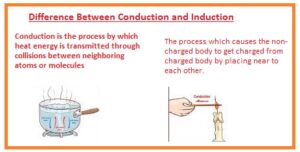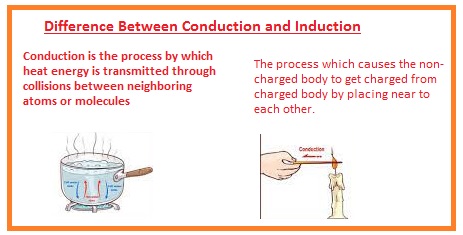 Hello guys, I hope you all are doing great. In today’s tutorial, we will discuss the Difference Between Conduction and Induction. Conduction is a process through which a body gets charged through the charged body by physical connection. However in induction, the non-charge body gets charged through the charged body without the physical connection.
Hello guys, I hope you all are doing great. In today’s tutorial, we will discuss the Difference Between Conduction and Induction. Conduction is a process through which a body gets charged through the charged body by physical connection. However in induction, the non-charge body gets charged through the charged body without the physical connection.
In today’s post, we will look at both charging processes and discuss their parameters to find differences between them. This article will help you if you need to write a detailed essay on this topic, including the differences and similarities of these 2 processes. Of course, you can also pay for essay online and get assistance. However, you should still have an understanding of what was written for you, so it’s worth delving into this topic as thoroughly as possible. So let’s get started with the Difference Between Conduction and Induction.
Difference Between Conduction and Induction
Conduction
- Conduction is a process through which current flows due to the electric field.
- To flow of current in the neutral body there is a need of a physical connection between charge and non-charge bodies.
- In conduction, energy is transferred through the collision of particles of objects.
- The colliding particles of objects can be either atoms or ion molecules.
- Conduction can occur in any material like solid gas and liquid.
- In this process heat transfer occurs spontaneously from a hot to a cold object.
- Is example is heat transfer from a stove to a pan placed on it.
- In this process heat transfer occurs in the body.
- This process is a combination of conduction and thermal radiation
- During this process, the current flows in a similar direction in both conductors.
- For transfer of the charge gradient path is required for this process.
- During this process, charges decrease on one body and increase on others due to distribution.
What is Thermal Conduction
- In this type of conduction, energy is transferred through the movement of electrons in the body and after making a collision with the particles.
- These motion particles can be electrons, atoms, and ions that collide and transfer energy in the form of internal energy or heat.
- It is a property of heat that it flows on its own from high temperature to low temperature. Its example is the transfer of heat from the stove to the pan placed on it.
What is Steady-State Conduction
- This condition occurs when temperature differences come with constant values that mean certain objects will have a constant temperature at the body.
What is Transient Conduction
- The time duration through which temperature changes at any portion of the object is known as transient conduction. This technique is also called non-steady-state conduction.
What is Induction
- For induction, current flows due to changes in the magnetic field.
- Work with only AC.
- The source is opposed to the current
- Faraday law defines it
- For transfer of charge, there is no need for a physical connection for induction.
- In this process induced current flows in the opposite direction to the charged body current flow direction.
- For this process, there is no need for a gradient path.
- During charge transferring its amount remains constant.
induction vs conduction
| Features | Conduction | Induction |
|---|---|---|
| Function | It causes current flow due to the electric field | Current is due to the magnetic field |
| Arrangement of conductors | It needed direct contact between charged and uncharged conductors. | There is no direct contact needed between charged and uncharged bodies. |
| Direction of current | Current in both conductors is the same direction | Induced current reverse to real current |
| Gradient path | There is a need for a gradient path due to the charges transferring nature. | There is no need of a gradient path due to the inducing nature of charges |
| Amount of charge | Less due to charges distribution | constant |
Read also:
FAQs
- The main difference between them is physical contact. Conduction needs direct contact with the conductor and induction no need direct contact with the conductor
- In induction, the charged object is taken closer to but not in contact with the object being charged, conduction comes with the physical connection of the charged object to neutral bodies
- Charging by conduction has the same charge as a charge on the external body and in induction charge is opposite to nature. In conduction, two bodies touch in induction not contact exists.
What is the difference between conduction and convection?
- In conduction, heat transfer is due to direct contact. In convection, heat transfer occurs in the fluid.
- Radiation defines heat transfer through electromagnetic waves, like microwaves, Conduction is heat transfer through direct contact between two objects. Convection is heat transfer through the motion of fluids. Induction is not heat transfer.
- Charging by conduction is a method of charging the uncharged object by making a connection wth another charged material. The negative and positive shared objects come with uneven charges.
- Current defines the flow of charge carriers through the conductor. Induced current defines movement charge carriers in conductors due to the existence of changing magnetic field.
- Conduction is energy transfer as heat or current through direct contact between matter or particles of matter.
- An example is touching a hot stovetop, or burning feet on hot sand
- Induction charging is a charging process that charges bodies without touching objects with charged objects. The charging by induction is where charged particles are held close to uncharged conductive material that is grounded on neutral charged material.
- Conduction is the process of transferring charges from charged body to a neutral object. Induction is the process of inducing charges on the neutral body through the charged body.
- Earthing is important for induction charging to protect devices being charged and ensure sure safety of the people around.
- The difference between charging by induction and conduction is the contact of a neutral object and the object used to charge it. Conduction needed direct contact and induction not needed.
- The charging by induction, electroscope is electrically neutral. For charging by conduction, an electroscope is positively or negatively charged with the transfer of electrons.
- Conduction is the transfer of energy from one atom to another through contact, its main types are ionic conduction, electric conduction, or heat conduction.
- An example is the heating of a pan on a stove. The heat from the burner transfers directly to the pan surface. Temperature measures Kinetic energy processed with particles of matter.
Read Our Latest Guides:
Between DL2032 and CR2032 Batteries







